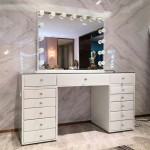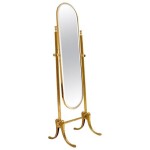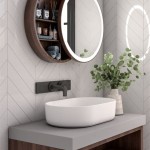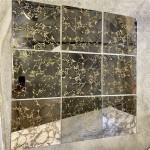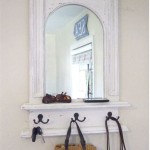Antique White Mirror: A Timeless Accent
The antique white mirror transcends mere functionality, evolving into a statement piece that complements a diverse range of interior design styles. Its subdued elegance and versatile color palette offer a counterpoint to bolder hues and stark modern lines, injecting warmth and character into any space. The term "antique white," while often associated with aged finishes, encompasses a spectrum of off-white shades, ranging from creamy ivories to subtle eggshell tones, each possessing its unique appeal and suitability for different design contexts.
This article delves into the characteristics, applications, and considerations surrounding the antique white mirror, examining its enduring popularity and providing insights into its integration within various aesthetic frameworks. From understanding the variations in antique white finishes to exploring the different styles and sizes available, this exploration aims to provide a comprehensive overview for those seeking to incorporate this refined accent into their homes or design projects.
Understanding Antique White Finishes
The term "antique white" isn't a singular, standardized color but rather a collection of off-white shades designed to evoke a sense of age and timelessness. Several factors contribute to the nuance of an antique white finish, including the base paint color, the application technique, and any subsequent treatments designed to simulate wear and tear. Understanding these variations is crucial when selecting an antique white mirror to ensure it harmonizes with the existing color scheme and desired aesthetic.
One common shade is a creamy ivory, which leans towards a warmer undertone, often incorporating subtle hints of yellow or beige. This type of antique white works well in traditional settings, complementing rich wood tones and soft, inviting color palettes. Conversely, a more muted eggshell antique white offers a cooler, slightly more contemporary feel. This shade tends to blend seamlessly with neutral backdrops and can provide a refreshing contrast against darker wall colors.
The process of creating an antique white finish often involves layering paint and employing techniques such as distressing, glazing, or dry brushing. Distressing involves intentionally creating imperfections, such as scratches, dents, and worn edges, to mimic the effects of time. Glazing involves applying a thin layer of tinted varnish or paint to highlight details and create depth. Dry brushing, on the other hand, uses a nearly dry brush to apply paint, creating a textured, weathered appearance. These techniques contribute to the unique character of each antique white mirror, ensuring that no two pieces are exactly alike.
The material upon which the antique white finish is applied also plays a role in the final appearance. Wood, for instance, may exhibit subtle grain patterns that are accentuated by the finish, adding to its rustic charm. Metal frames, on the other hand, can be treated with techniques that mimic the look of aged patina, creating a sense of historical authenticity. The interplay between the material and the finish is a key consideration when selecting an antique white mirror, as it directly impacts its overall visual impact.
The color and intensity of lighting within a room can significantly alter the perceived shade of antique white. In warm, incandescent light, an antique white finish may appear warmer and more yellow, while in cool, fluorescent light, it may appear cooler and more gray. Therefore, it's essential to consider the lighting conditions when selecting an antique white mirror to ensure that it complements the existing environment.
Styles and Sizes of Antique White Mirrors
Antique white mirrors are available in a diverse range of styles and sizes, catering to a variety of aesthetic preferences and functional requirements. From ornate, vintage-inspired designs to sleek, minimalist frames, the options are virtually limitless. Selecting the appropriate style and size is crucial to ensure that the mirror seamlessly integrates into the intended space and serves its intended purpose.
For those seeking a touch of classic elegance, ornate antique white mirrors with intricate carvings and gilded accents are an excellent choice. These mirrors often feature elaborate frames reminiscent of French Rococo or Victorian designs, adding a touch of grandeur to any room. They are particularly well-suited for formal living rooms, dining rooms, or bedrooms where a sense of luxurious sophistication is desired.
Alternatively, those with a preference for more understated designs may opt for antique white mirrors with simpler, more geometric frames. These mirrors often feature clean lines and minimal detailing, making them a versatile choice for contemporary or transitional spaces. They can be used in a variety of settings, from bathrooms and hallways to bedrooms and living rooms, adding a touch of subtle elegance without overwhelming the existing decor.
The size of the antique white mirror is another important factor to consider. Large mirrors can create the illusion of more space, making them ideal for smaller rooms or areas with limited natural light. They can also serve as a focal point, drawing the eye and creating a sense of drama. Smaller mirrors, on the other hand, are well-suited for accentuating specific areas or adding a touch of visual interest to a gallery wall. They can also be used in bathrooms as vanity mirrors or in hallways as decorative accents.
The shape of the mirror also contributes to its overall aesthetic. Round mirrors offer a softer, more organic feel, while rectangular mirrors provide a more structured and formal look. Oval mirrors can add a touch of vintage charm, while square mirrors offer a clean and contemporary aesthetic. The shape of the mirror should be carefully considered in relation to the surrounding decor and the desired overall effect.
Floor-length antique white mirrors are particularly popular for bedrooms and dressing rooms, providing a full-body reflection and adding a touch of glamour. These mirrors can be leaned against a wall or mounted for a more permanent installation. Smaller table mirrors are also a popular choice for vanities or dressing tables, providing a convenient and stylish way to apply makeup or style hair.
Applications and Design Considerations
The versatility of the antique white mirror makes it a valuable asset in a wide range of design applications. From enhancing natural light to creating a focal point, its ability to complement diverse aesthetic styles allows for seamless integration into almost any space. Thoughtful consideration of placement, surrounding décor, and desired effect is key to maximizing its impact.
One of the most common applications of antique white mirrors is to enhance natural light. By strategically positioning the mirror opposite a window, natural light can be reflected back into the room, creating a brighter and more airy atmosphere. This technique is particularly effective in smaller rooms or spaces with limited natural light, such as hallways or bathrooms.
Antique white mirrors can also be used to create a focal point in a room. A large, ornate mirror can be hung above a fireplace, console table, or headboard, drawing the eye and creating a sense of drama. The mirror's reflective surface can also add depth and dimension to the space, making it feel larger and more inviting.
In bathrooms, antique white mirrors are often used as vanity mirrors, providing a functional and stylish way to apply makeup or style hair. The soft, neutral tones of the antique white finish can create a calming and relaxing atmosphere, perfect for a spa-like bathroom retreat. The mirror can be paired with antique white cabinets or fixtures to create a cohesive and harmonious design.
Antique white mirrors can also be incorporated into gallery walls, adding a touch of visual interest and creating a dynamic and eclectic display. The mirror can be mixed with artwork, photographs, and other decorative items to create a unique and personalized space. The antique white finish provides a neutral backdrop that allows the other items to shine.
When selecting an antique white mirror, it's important to consider the existing color scheme and décor of the room. The mirror should complement the surrounding colors and textures, creating a harmonious and balanced look. The finish should also be appropriate for the overall style of the room, whether it's traditional, contemporary, or transitional.
The hardware used to hang the mirror can also impact its overall appearance. Antique brass or bronze hardware can complement the antique white finish, adding a touch of vintage charm. Nickel or chrome hardware can provide a more contemporary and streamlined look. The hardware should be chosen carefully to ensure that it complements the mirror and the surrounding décor.
Ultimately, the antique white mirror is a versatile and timeless accent that can enhance any space. By understanding the different finishes, styles, and applications available, individuals can effectively incorporate this elegant piece into their homes or design projects, achieving a refined and sophisticated aesthetic.

White Solid Wood Antique Rectangle Wall Mirror 30x42

French Mirror White Lacquer 1 Left In Stock Interior Design Baroque Furniture 5 5ft X 7 Rococo Vintage

Antique White French Ivory Shabby Chic Over Mantle Scroll Arch Wall Mirror

Large Distressed Antique White Farmhouse Mirror 30 X 50 Lightusa

West Frames Elegance French Ornate Embossed Antique White Gold Framed Wood Wall Mirror

Antique White Cream Dress Ornate French Shabby Chic Leaner Floor Wall Mirror 6ft

Louis Style White Ornate Rectangle Antique Wall Mirror 4 Ft X 3 Large Shabby Chic Decor

Antique White Framed Mirror 60 X 80cm Jysk Ca

Classic Vintage Antique White Wall Mirror 8

Sandy Antique White Rectangle Mirror 120cm X 90cm Mirrors Exclusive
